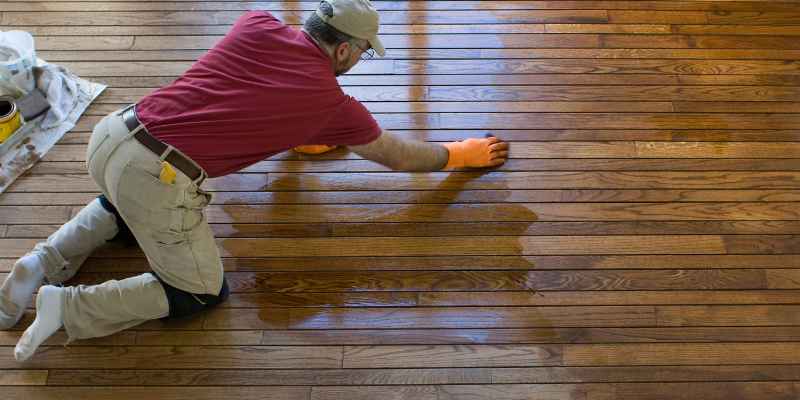Refinishing hardwood floors involves sanding down the surface and applying a new stain or finish. It’s a process to restore and enhance the appearance of hardwood floors, increasing their lifespan.
Refinishing hardwood floors is a valuable investment that not only revitalizes the look of the floors but also prolongs their durability. With proper maintenance, this process can be done every seven to ten years, preserving the beauty and integrity of the hardwood.
Understanding the refinishing process and its benefits can help homeowners make informed decisions about maintaining and improving their hardwood floors. By learning the difference between resurfacing and refinishing, individuals can choose the most suitable method to revitalize their hardwood floors.
Introduction To Hardwood Floor Refinishing
Refinishing hardwood floors is the process of sanding down the surface and applying a new stain or finish to revitalize the wood. It not only enhances the appearance of the floors but also extends their lifespan. Discover the steps involved and the benefits of refinishing your hardwood floors.
Benefits Of Refinishing
Refinishing hardwood floors offers numerous benefits, such as:
- Restoring the natural beauty and elegance of the wood
- Extending the lifespan of the floors
- Enhancing the overall aesthetic appeal of the space
- Increasing the value of the property
- Improving indoor air quality by removing accumulated dust and allergens
Refinishing Vs. Resurfacing
Refinishing and resurfacing are two distinct processes for rejuvenating hardwood floors:
| Refinishing | Resurfacing |
| Involves sanding down the surface and applying a new stain or finish | Entails applying a new layer of material on top of the existing flooring |
| Restores the original wood to its former glory | Covers the existing surface with a new material |
| Can address deep scratches, dents, and stains | Best for addressing minor surface imperfections |
Both processes have their unique advantages, and the choice between refinishing and resurfacing depends on the condition of the floors and the desired outcome.

Signs Your Hardwood Floor Needs Refinishing
Refinishing hardwood floors is the process of sanding down the surface and applying a new stain or finish. Signs that your hardwood floor needs refinishing include scratches, dullness, and wear patterns. By refinishing your floors, you can restore their appearance and prolong their lifespan.
Visible Wear And Tear
Over time, hardwood floors can become scratched, dented, and worn due to daily wear and tear. If you start to notice visible wear and tear on your hardwood floors, such as scratches, dents, or gouges, it may be time to consider refinishing them. Refinishing your hardwood floors can repair the damage and restore them to their former glory.
Fading And Discoloration
Another sign that your hardwood floors may need refinishing is fading or discoloration. Sun exposure and age can cause hardwood floors to lose their color and become dull. If you notice that your hardwood floors are no longer the vibrant color they once were, it may be time to refinish them. Refinishing can help bring back the color and shine of your hardwood floors, making them look like new again.
If you’re not sure whether your hardwood floors need refinishing or not, you can perform a simple test. Pour a small amount of water onto your hardwood floors. If the water beads up and sits on top of the wood, your floors are still sealed and don’t need refinishing yet. But, if the water soaks into the wood and causes it to darken, your floors are no longer sealed and need to be refinished.
In conclusion, refinishing your hardwood floors can help restore them to their former glory and increase their lifespan. If you notice visible wear and tear or fading and discoloration, it may be time to consider refinishing your hardwood floors. Don’t wait until the damage is irreversible. Refinishing your hardwood floors is a worthwhile investment that will enhance the look of your home and increase the value of your property.
Preparation For Refinishing
Refinishing hardwood floors involves sanding down the surface of the floors and applying a new stain or finish. The preparation for refinishing includes prepping the room for work, removing shoe molding, sanding the floor, detail sanding edges and corners, screen sanding the floor, applying a new stain, and applying a finish.
Refinishing your hardwood floors is a worthwhile investment that enhances the look of your floors and increases their lifespan.
Before you can begin the process of refinishing hardwood floors, it is important to properly prepare the room and gather all the necessary materials and tools. This step is crucial to ensure that the refinishing process goes smoothly and yields the best results.
Clearing The Room
The first step in preparing for refinishing hardwood floors is to clear the room of all furniture, rugs, and any other items that may obstruct the refinishing process. It is important to have a clean and empty space to work with, allowing easy access to the entire floor surface.
Gathering Materials And Tools
Once the room is cleared, the next step is to gather all the materials and tools needed for the refinishing process. Here is a list of the essential items you will need:
- Safety goggles and dust mask
- Protective clothing
- Drum sander
- Palm sander and buffer
- Sandpaper in various grits
- Stain and finish of your choice
- Paintbrushes and/or applicators
- Shop vacuum or broom
- Tape and plastic sheets for masking
- Putty knife and wood filler
Having all these materials and tools ready before you start refinishing will save you time and ensure a smooth workflow throughout the process.
Remember, proper preparation is key to achieving professional-looking results when refinishing hardwood floors. Clearing the room and gathering all the necessary materials and tools will set you up for success and make the refinishing process much easier.
Sanding: The First Step
The first step in refinishing hardwood floors is sanding. This process involves removing the old finish to allow the wood to absorb the new stain, followed by additional sanding for a smooth finish. Refinishing hardwood floors can revitalize your space and extend the life of your flooring.
Choosing The Right Sandpaper
When it comes to refinishing hardwood floors, sanding is the first crucial step. Choosing the right sandpaper is essential to ensure a smooth and even finish. The type of sandpaper you use will depend on the condition of your floors and the level of sanding required.
For initial sanding or removing old finishes, a coarse-grit sandpaper, such as 36 or 40 grit, is recommended. This grit helps to quickly remove the existing finish and any deep scratches or imperfections on the surface. As you progress to finer grits, such as 60 or 80 grit, you’ll achieve a smoother surface and prepare it for the next steps in the refinishing process.
When it comes to sanding hardwood floors, it’s important to have a variety of grits on hand. This allows you to start with a coarser grit and gradually work your way up to finer grits for a polished and professional finish.
Sanding Techniques
Now that you have the right sandpaper, it’s time to learn some sanding techniques to achieve the best results. Sanding hardwood floors requires careful attention to detail and a methodical approach. Here are some key techniques to keep in mind:
- Start with a drum sander: A drum sander is a powerful machine that removes the bulk of the old finish and levels the surface. Move the sander in a straight line, going with the grain of the wood, to ensure an even sanding pattern.
- Hand sand the edges: The drum sander cannot reach the edges of the room, so you’ll need to use a handheld sander to sand the edges. Be careful not to sand too aggressively, as it can create uneven areas.
- Use a palm sander for detail sanding: After using the drum sander, switch to a palm sander to sand the corners and hard-to-reach areas. This will help achieve a smooth and consistent finish throughout the entire floor.
- Apply even pressure: When sanding with any type of sander, it’s important to apply even pressure to avoid creating low or high spots on the floor. Keep the sander moving at a steady pace to prevent over-sanding in one area.
By following these sanding techniques and using the right sandpaper, you’ll be on your way to achieving beautifully refinished hardwood floors that will enhance the overall look of your space.
Detail Work On Edges And Corners
Refinishing hardwood floors involves sanding down the surface of your floors and applying a new stain or finish. This process is done to enhance the look of your floors and increase their lifespan. Detail work on edges and corners is a crucial step in the process of refinishing hardwood floors.
Hand Sanding For Precision
Hand sanding is essential for getting precision in the corners and edges of your hardwood floors. This is because it is not possible to reach these areas with a machine. Hand sanding will ensure that every inch of your floor is smooth and even.
Dealing With Tough Spots
When refinishing hardwood floors, you may come across tough spots that are difficult to sand down. These spots can include deep scratches, dents, or stains. To deal with tough spots, you may need to use a more aggressive sandpaper or even a handheld rotary tool to sand them down.
After sanding down the tough spots, it is important to ensure that the area is smooth and even. You may need to use a finer grit sandpaper to achieve this. It is also important to ensure that the color of the spot matches the rest of the floor. If it does not, you may need to apply a stain to the spot before applying the finish.
Detail work on edges and corners is a crucial step in the process of refinishing hardwood floors. Hand sanding for precision and dealing with tough spots are important aspects of this step. By taking the time to do this detail work, you can ensure that your hardwood floors look beautiful and last for years to come.
Choosing The Right Stain Or Finish
Refinishing hardwood floors involves sanding down the surface of the floors and applying a new stain or finish. It is a worthwhile investment as it enhances the look of the floors and increases their lifespan. Choosing the right stain or finish is crucial in achieving the desired outcome for your hardwood floors.
Types Of Finishes
Stain Application Tips
When it comes to refinishing hardwood floors, choosing the right stain or finish is crucial for achieving the desired look and durability. Different types of finishes offer varying levels of protection and aesthetics, so it’s important to select the one that best suits your needs.
Types Of Finishes
There are several types of finishes available for hardwood floors, each with its own unique characteristics:
- Polyurethane: Provides a durable and long-lasting finish, available in water-based and oil-based options.
- Lacquer: Offers a quick-drying finish with a high gloss, but may require more frequent touch-ups.
- Penetrating Oil Sealer: Enhances the natural look of the wood while providing moderate protection.
- Wax: Creates a soft, low-sheen finish that is easy to maintain but may require more frequent reapplication.
Stain Application Tips
When applying stain to your hardwood floors, follow these tips to ensure a smooth and even finish:
- Clean the surface thoroughly to remove any dirt or debris.
- Test the stain on a small inconspicuous area to ensure it achieves the desired color.
- Apply the stain evenly with a brush or rag, following the wood grain for a natural look.
- Allow the stain to dry completely before applying the finish coat.
By choosing the right stain or finish and following proper application techniques, you can rejuvenate your hardwood floors and enhance the overall aesthetic of your space.
Applying The New Finish
Refinishing hardwood floors involves sanding down the old finish and applying a new stain or finish to revitalize the wood. This process not only enhances the appearance of the floors but also prolongs their lifespan, making it a worthwhile investment.
With proper care, hardwood floors typically require refinishing every seven to ten years.
Best Practices For Even Application
When applying the new finish to hardwood floors, it is essential to ensure an even application for a seamless and professional look.
Drying And Curing Time
After applying the new finish, allow sufficient drying and curing time to ensure the coating sets properly for long-lasting results.
Maintenance Tips Post-refinishing
After refinishing your hardwood floors, proper maintenance is crucial to preserve their beauty and longevity. Follow these maintenance tips to ensure your floors stay pristine for years to come.
Regular Cleaning Routines
- Vacuum or sweep regularly to remove dirt and debris.
- Use a damp microfiber mop for gentle cleaning.
- Avoid harsh chemical cleaners that can damage the finish.
Preventing Future Damage
- Place felt pads under furniture legs to prevent scratches.
- Avoid walking on the floors with high heels or shoes with sharp edges.
- Control humidity levels to prevent warping or gaps in the wood.
Professional Vs. DIY Refinishing
Refinishing hardwood floors can transform the look of your space, but deciding between professional or DIY refinishing is crucial.
When To Call The Professionals
- If floors have extensive damage or require intricate repairs.
- For specialized equipment like drum sanders and buffers.
- When time constraints or lack of experience are a concern.
Costs And Considerations
| Professional Refinishing | DIY Refinishing |
|---|---|
| Higher upfront costs | Potential cost savings |
| Expertise and quality results | Time-consuming process |
| Quicker turnaround time | Opportunity for customization |

The Environmental Impact Of Refinishing
Refinishing hardwood floors involves sanding down the surface and applying a new stain or finish, enhancing the look and increasing their lifespan. However, it’s important to consider the environmental impact of refinishing, as the process can involve the use of chemicals and generate dust and fumes that can affect indoor air quality and the surrounding environment.
Proper disposal of materials and choosing environmentally friendly products can minimize the impact.
Refinishing hardwood floors is a great way to breathe new life into your space. However, it’s important to consider the environmental impact of this process. From the chemicals used to the waste produced, refinishing can have a significant impact on the planet. That’s why it’s important to choose eco-friendly products and sustainable practices when refinishing hardwood floors.
Eco-Friendly Products
Using eco-friendly products is a great way to minimize the environmental impact of refinishing hardwood floors. Look for products that are labeled as low or zero VOC (volatile organic compounds). These products are free from harmful chemicals that can pollute the air and harm your health. Additionally, using water-based finishes instead of oil-based finishes can also reduce the amount of VOCs released into the air.
Sustainable Practices
In addition to using eco-friendly products, incorporating sustainable practices into the refinishing process can also reduce the environmental impact. For example, instead of using disposable sandpaper, consider using a sanding screen that can be washed and reused. Additionally, instead of tossing old flooring materials in the trash, consider repurposing them or donating them to a local organization.
By using eco-friendly products and sustainable practices, you can minimize the environmental impact of refinishing hardwood floors. Not only will this benefit the planet, but it will also create a healthier living environment for you and your family. So, before starting your refinishing project, take the time to consider the impact of your choices and make environmentally conscious decisions.
Frequently Asked Questions
Is Refinishing Hardwood Floors Worth It?
Refinishing hardwood floors is definitely worth it, enhancing their appearance and extending their lifespan. It’s a valuable investment for your home.
What’s The Difference Between Resurfacing And Refinishing Hardwood Floors?
Resurfacing adds a new layer, while refinishing involves sanding and applying a new finish.
What Is The Process Of Refinishing Hardwood Floors?
Refinishing hardwood floors involves several steps to restore the appearance and durability of the wood. First, the room is prepared and shoe molding is removed. Next, the floor is sanded, including the edges and corners. After that, a new stain is applied, followed by a finish.
This process can help extend the lifespan of the floors and enhance their overall look.
How Often Do Hardwood Floors Need To Be Refinished?
Hardwood floors should be refinished every seven to ten years to maintain their appearance and durability. Regular refinishing can enhance the look of the floors and extend their lifespan.
Conclusion
Refinishing hardwood floors is a valuable investment that enhances the appearance and longevity of your floors. This process involves sanding and applying a new finish, revitalizing the natural beauty of the wood. With proper maintenance, refinishing can be done every 7-10 years to keep your floors looking pristine.

